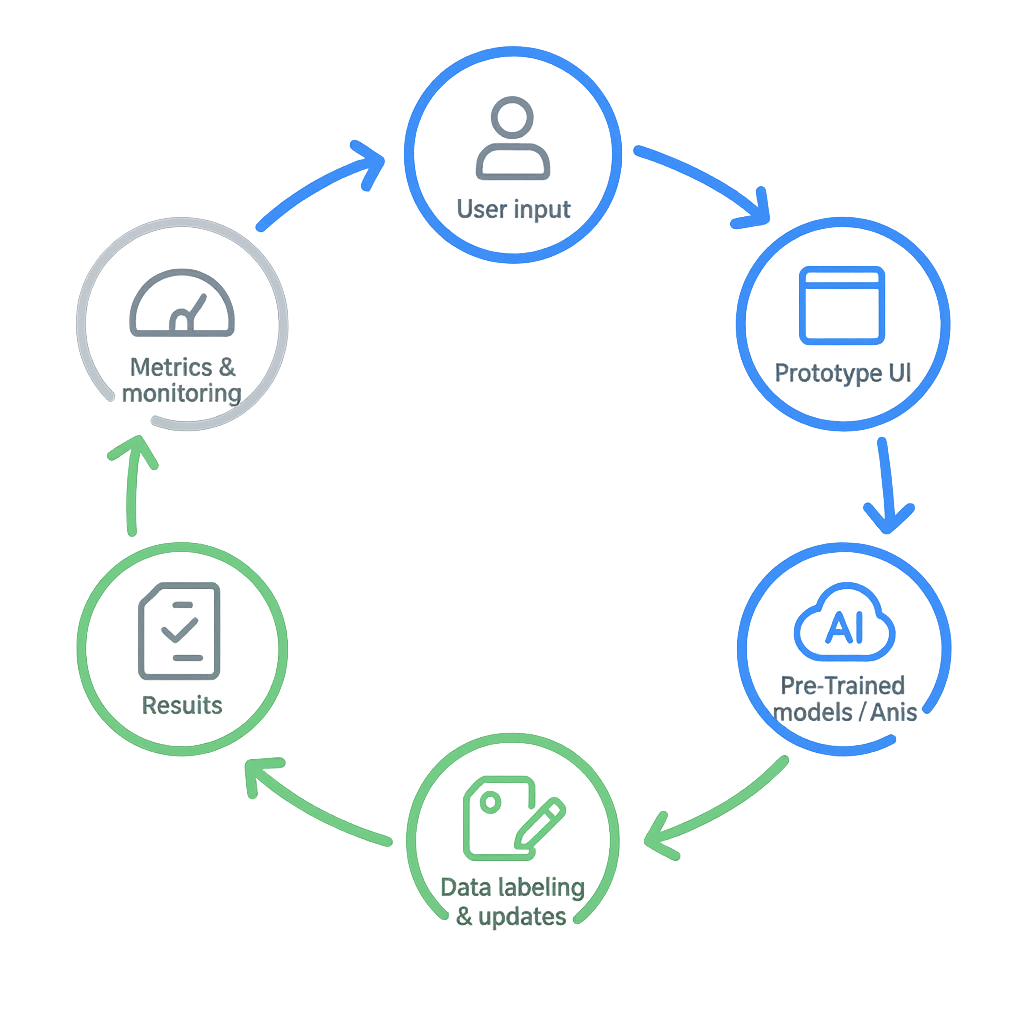What UI/UX Design Services Can Do for Your Business

Introduction
Your idea needs to be tested quickly and without being costly. AI development may be expensive, but a tiny team and a low budget can create a useful AI MVP. An AI MVP is a small, testable form of your concept demonstrating core value. The idea is to get to know the real users swiftly and eliminate risk before you spend more.
What makes an AI MVP different
AI MVP is a prototype with intelligence added. You add something other than just UI and flows, such as a model or data-driven feature, such as recommendations or automation. This introduces new requirements: information, model correctness, and computation. These influence the AI MVP development process and must be planned.
Step 1: Supporting the core problem and value.
Start with one clear problem. Question: Who has this problem? Why is it so? Confirm fast by speaking to some users or conducting a brief survey. Then list the role of the AI: will it prioritize items, propose answers, or identify problems? Having a small product idea reduces the likelihood of creating the wrong product.
Step 2: Select the feature to prototype that is the simplest.
Select one specific use case, and that is all. Examples: a chatbot responding to the five most popular questions, a simple recommender to one product category, or an image classifier to one defect. Scopes of narrow data requirements reduce data requirements and expedite testing. Concentrate on demonstrating worthiness, not excellence.
Step 3: Code with low and no-code.
Platforms that use low-code and hosted APIs get started quickly. Prototyping can be done using tools such as AutoML services, drag-and-drop builders, and public model APIs, which allow individuals who are not experts to do so. These platforms also save time and money, but some are limited in customization. Choose platforms that will enable you to either export or integrate with APIs so that you can switch strategies in the future.
Step 4: Leverage pre-trained models and open-source tools
Training from scratch is costly. Start with pre-trained models (language, vision) and open-source frameworks like TensorFlow or PyTorch. You can often fine-tune a model with a small dataset or call a hosted API only when needed. This approach lowers compute costs and keeps focus on users.

Step 5: Develop a very basic prototype and prototype it with the users.
Create a lightweight web prototype that can be clicked on and contains one AI function. Present it to the actual users and observe the way they interact. Measure easy things: tasks done, time wasted, or the frequency of user acceptance of AI suggestions. Gather feedback and repeat quickly. Minor incremental improvements are superior to long development cycles.
Step 6: Step-by-step automation and scaling.
Once the users are interested, automate repetitive tasks such as labeling and testing to save time. The only time to increase the model complexity is when it enhances user results. Take key components to production earlier and retain the prototype’s non-critical functions. Monitor to check the possibility of surprises or scale failures.
Common mistakes to avoid
Avoid overengineering. Do not build big models unless you have proved the concept. Collecting data that you do not need will be expensive and risky. Forget about privacy and bias—get consent and test the model with multiple groups early. Do not forget that utility and confidence on the user’s part are more important than flawless accuracy.
Financial fundamentals: where and how to save money.
Some of the most common costs include small datasets and labeling, tool or API charges, developer time, and hosting. Conserve through open source models, cloud credits, and temporary, focused work outsourcing. The most significant part of the expenses should be spent on the items that accelerate the learning process: a small dataset with labels and a functional prototype. Development of costly production tasks until users validate the concept.
Real-world examples of AI development
A tiny store made product recommendations in one of the categories with a basic recommender, and conversions increased. A pre-trained vision model that used a small number of images to triage photos was used in a clinic; clinicians rapidly embraced the tool. The chatbot with no code and responding to the five most popular questions was launched, and the response time was reduced significantly. They both began small, which was confirmed, and grew only through learning.
Conclusion: learn to scale, learn fast, start small.
Developing an AI MVP on a low-resource basis concerns focus and velocity. Identify a narrow task, select a single easy AI feature, write low-code applications or pre-trained models, and test on actual users. You can only automate and scale when you have already proven your value. Low budgets do not reduce effectiveness, but they compel more intelligent decisions.
Call to action
Do you need assistance developing your idea into a pilot AI MVP? MVPcenter could assist in prototyping and initial AI development. Take your issue, not a finished product, and have a cheap, quick pilot that real users can test.
Connect with MVP Center
Ready to take the first step towards unlocking opportunities, realizing goals, and embracing innovation? We're here and eager to connect.




